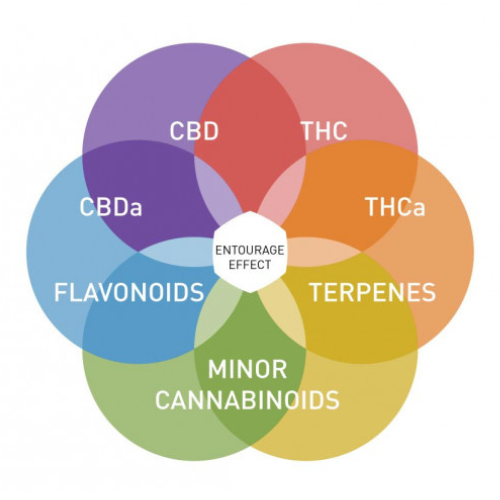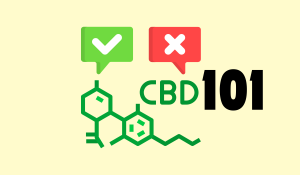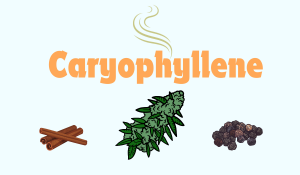Terpenes are organic compounds produced by plants that serve as the primary constituents of essential oils. These aromatic compounds are responsible for the distinct aromas and flavors of various plants. In chemical terms, terpenes are hydrocarbons derived from repeating isoprene units and are synthesized through the mevalonic acid pathway in plants.
Terpenes are abundantly present in cannabis, alongside other plants like mint, lemon, and pine.
In cannabis, terpenes enrich the plant’s aromatic profile and also interact synergistically with cannabinoids, such as THC and CBD. This interaction, often referred to as the “entourage effect,” suggests that the therapeutic efficacy of cannabis can be enhanced when multiple compounds work together.

The “entourage effect” is a phenomenon where terpenes and cannabinoids work synergistically to enhance the overall therapeutic effects of cannabis. This interaction between terpenes and cannabinoids, such as THC and CBD, amplifies the efficacy of cannabis strains.
For example, the combination of myrcene’s sedative properties with THC results in a strain that can offer profound relaxation and pain relief.
Terpene charts serve as essential tools for understanding the diverse roles and effects of terpenes found in various plants, particularly cannabis. These charts visually represent the numerous terpenes, detailing their aromatic profiles, potential effects, and associated benefits. Typically, a comprehensive terpene chart includes several key categories:
Understanding a terpene chart requires familiarity with its structure and the significance of each listed category. Reading these charts effectively can help individuals make informed choices regarding plant-based products, especially for therapeutic purposes or in selecting cannabis strains.
By familiarizing oneself with these categories, interpreting terpene charts becomes more intuitive, enabling more personalized and knowledgeable choices.
For those looking to delve deeper into the world of terpenes, a printable terpene chart can be an invaluable resource. These charts provide a visual representation of various terpenes, detailing their aromatic profiles, potential effects, and associated benefits.
By having a physical copy, users can easily reference the information when selecting cannabis strains or essential oils, ensuring they choose products that align with their desired outcomes.

Terpenes are organic aromatic compounds found in many plants, including cannabis. Each terpene has unique characteristics that influence their aroma, effects, and potential medical benefits. This chapter delves into five popular terpenes: Myrcene, Limonene, Pinene, Linalool, and Caryophyllene.
Myrcene is one of the most abundant terpenes in cannabis. It is known for its earthy, musky aroma, reminiscent of cloves. Some strains also have hints of citrus and fruits. Myrcene is associated with sedative and muscle relaxant effects, making it useful for pain relief and aiding with sleep.
Myrcene is commonly found in:
Limonene is easily recognizable by its strong citrus scent, akin to lemons and oranges. It is known for its uplifting and stress-relieving properties. Limonene is often used in mood-enhancement treatments and has potential anti-anxiety effects.
Limonene can be found in:
Pinene smells like pine needles, fir trees, and also has a refreshing, woody scent. It is noted for its anti-inflammatory, bronchodilator, and memory-boosting effects. Pinene can help with alertness and energy.
Pinene is prevalent in:
Linalool exudes a floral, lavender-like aroma with a hint of spiciness. It is reputed for its calming and sedative properties, often used to help with anxiety, depression, and insomnia.
Linalool is typically found in:
Caryophyllene has a spicy, peppery aroma, similar to cloves and black pepper. It is unique among terpenes for its ability to act as a cannabinoid, directly interacting with CB2 receptors. This gives it potential anti-inflammatory, analgesic, and anti-anxiety properties.
Caryophyllene is commonly sourced from:
Terpenes such as Myrcene, Limonene, Pinene, Linalool, and Caryophyllene have profoundly different aromas and effects, shaped by their chemical structures and sources. Understanding these profiles can guide individuals in making informed choices about their plant-based products.
Terpenes play a significant role in defining the unique characteristics of cannabis strains. These aromatic compounds not only contribute to the distinct flavors and aromas of each strain but also greatly influence their effects. Understanding terpene profiles helps consumers and medical patients select the most suitable strains for their needs. By examining the specific combination of terpenes present in a strain, one can predict its therapeutic benefits, flavor, and overall experience.
Each terpene has unique properties that contribute to the entourage effect, where terpenes interact synergistically with cannabinoids such as THC and CBD.
For example:
Terpene charts serve as valuable tools for navigating the complex world of cannabis strains. These charts typically list terpenes alongside their associated effects, aromas, and potential medical benefits. To use a terpene chart effectively:
By using these steps, consumers can personalize their cannabis experience, ensuring they receive the most appropriate strain for their needs.
Understanding and leveraging terpene profiles empowers individuals to make informed decisions, enhancing both medicinal and recreational cannabis use.

What Is the Proper Dosage of CBD Oil? Knowing the right CBD oil dosage is essential before starting your regimen. While personal factors and specific...
Read More
Watch Now CBD Dosage for Dogs: Starting Small When introducing CBD oil to your dog’s regimen, it’s crucial to start with a small dose and...
Read More
What Is CBD? CBD is one of over 100 natural compounds called cannabinoids found in the Cannabis sativa plant. Unlike THC (tetrahydrocannabinol), the well-known psychoactive...
Read More
What is Limonene? Limonene is a naturally occurring aromatic compound that belongs to the family of terpenes. Terpenes are organic compounds produced by a variety...
Read More
What Does the Terpene Caryophyllene Do? Caryophyllene, a unique sesquiterpene found in various plants including cannabis, black pepper, and cloves, stands out for its ability...
Read More
Chemical Structure and Properties Terpinolene is a monocyclic monoterpene, which means it’s made up of a single ring of carbon atoms with a few hydrogen...
Read More
The cannabis plant contains over 100 different cannabinoids, each with its unique properties and effects. Among these, THCA and Delta 9 THC stand out due...
Read More
THCA vs THC: A Molecular Comparison At first glance, THCA and THC might seem like twins. But look closer, and you’ll see they’re more like...
Read More
How to Use CBD Oil for Epilepsy in Adults CBD oil can be administered in various ways, each offering different benefits and levels of convenience....
Read More
Watch Now Ingredients and Supplies To make CBD oil at home using the oil method, you will need the following: Ingredients: * other food-grade oils...
Read More